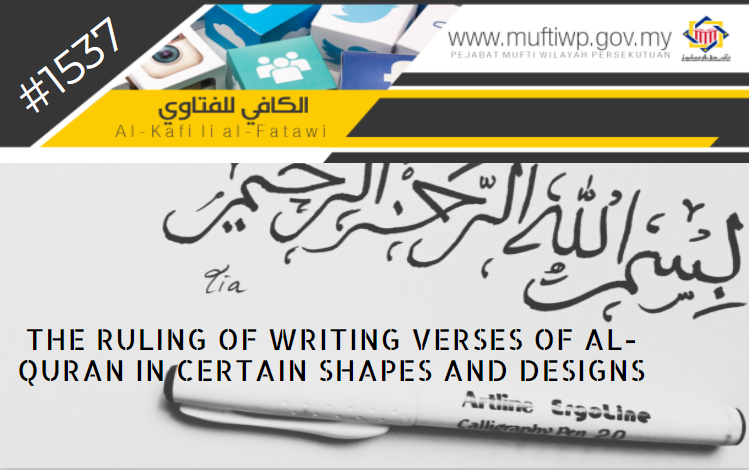Question:
Assalamualaikum SS Datuk Mufti. What is the ruling of writing verses of al-Quran in certain shapes like the shape of wau (Malay traditional kite), flowers and etc.? Hope for an explanation.
Answer:
Alhamdulillah, praise and thanks to Allah for the many countless blessings He has blessed us all with. Blessings and salutations to the Prophet Muhammad PBUH, his wives, his family, companions and all those that follow his teachings to the day of judgement.
Basically, verses of al-Quran shall be dignified, honoured and be free from anything that may lead to depravity and degrading. Imam al-Nawawi in stressing upon this matter states: “The scholars have decided on that it is wajib to preserve mushaf al-Quran and honour it.” (See al-Tibyan fi Adab Hamalat al-Quran, pg.190).
The majority of the scholars stated that it is wajib for a Muslim to be pure from minor and major impurities before touching mushaf as well as while carrying it. Allah SWT says:
لَّا يَمَسُّهُ إِلَّا الْمُطَهَّرُونَ
None touch it except the purified.
Surah al-Waqi’ah (79)
In the book Nawadir al-Usul, it states: Touching, moving or carrying (lifting mushaf al-Quran) shall be done when one is in pure state (with wudhu’), whether the verses of al-Quran are written on paper, wood, metal, cloth and the like. (See Nawadir al-Usul fi Ma’rifah Ahadith al-Rasul, 2/392)
The main purpose of al-Quran being revealed is to be read, to be tadabbur upon, ponder, believed in and applied in a Muslim’s daily life.
Regarding the above question, we cite here the answer from the decision made by the Muzakarah of Fatwa of National Council for Islamic Religious Affairs dated 13th to 15th June 2005 in its 69th muzakarah, which states:
- The writing of verses of al-Quran in the form of excessive design which may cause confusion and makes it hard for the readers to understand is prohibited.
- Khat writing of verses of al-Quran may be done with the condition it is written correctly and easy to be read.
- Khat writing of verses of al-Quran shall not be mixed with other verses that may confuse the readers.
- Khat writing of verses of al-Quran shall be written completely and the arrangement of its verses shall not be half-half that may confuse or change it.
- It is prohibited if the Khat writing of the verses of al-Quran done in various shapes that cause confusion and erase the purposes of those verses be revealed which is to be read, understood and pondered upon. (See Kompilasi Muzakarah MKI 2016 – Jakim, pg. 210-211)
It is also mentioned: It is prohibited to write or shape verses of al-Quran in the form of animals, people, building, games like the wau, plants, flowers and the like. (See Garis Panduan Pembuatan, Pengendalian, Penjualan Dan Pelupusan Ayat Suci Al-Quran by JAKIM, pg. 5)
There is also a Garis Panduan Kaligrafi Al-Quran (Guidelines for Quranic Calligraphy Writing) endorsed by the Lembaga Pengawalan dan Pelesenan Pencetakan al-Qur’an Kementerian Dalam Negeri states that:
- It is prohibited to write Quranic calligraphy in the form of living creatures or any form which may degrade the sanctity of the Quran.
- The background of the calligraphy shall not contain any element of living creatures which does not suit the sanctity of al-Quran.
- Every writing shall be made in complete and follow the method of writing verses of al-Quran.
- Khat which is hard to be read like Khat Kufi Murabba’ and Khat Diwani Jaliyy shall include Khat Nasakh in smaller size at the bottom of the writing to ease the public in recognizing the Quranic calligraphy.
- Each writing shall be complete in term of its meaning and not suspended in the meaning. (See Garis Panduan Kaligrafi Al-Quran, pg. 6-7)
Conclusion
Based on the above statement, we are of the opinion that it is impermissible to write al-Quran in the forms of picture because it is part of degrading al-Quran. Also, it may rise many unhealthy interpretations and assumptions upon al-Quran while al-Quran is the book and kalam Allah which is holy and divine, wajib to be respected.
May we become the servants of Allah who truly love al-Quran. We end with the du’a:
اَللَّهُمَّ اجْعَلِ الْقُرْآنَ رَبِيعَ قُلُوْبِناَ، وَنُوْرَ صُدُوْرِناَ، وَجلاَءَ أَحْزَانِناَ، وَذهَابَ هُمُوْمِناَ
“O Allah, make al-Quran the calmer of our heart, the light which shines our chest, the lifter of our grief and wipe our sadness away”
Ameen.


